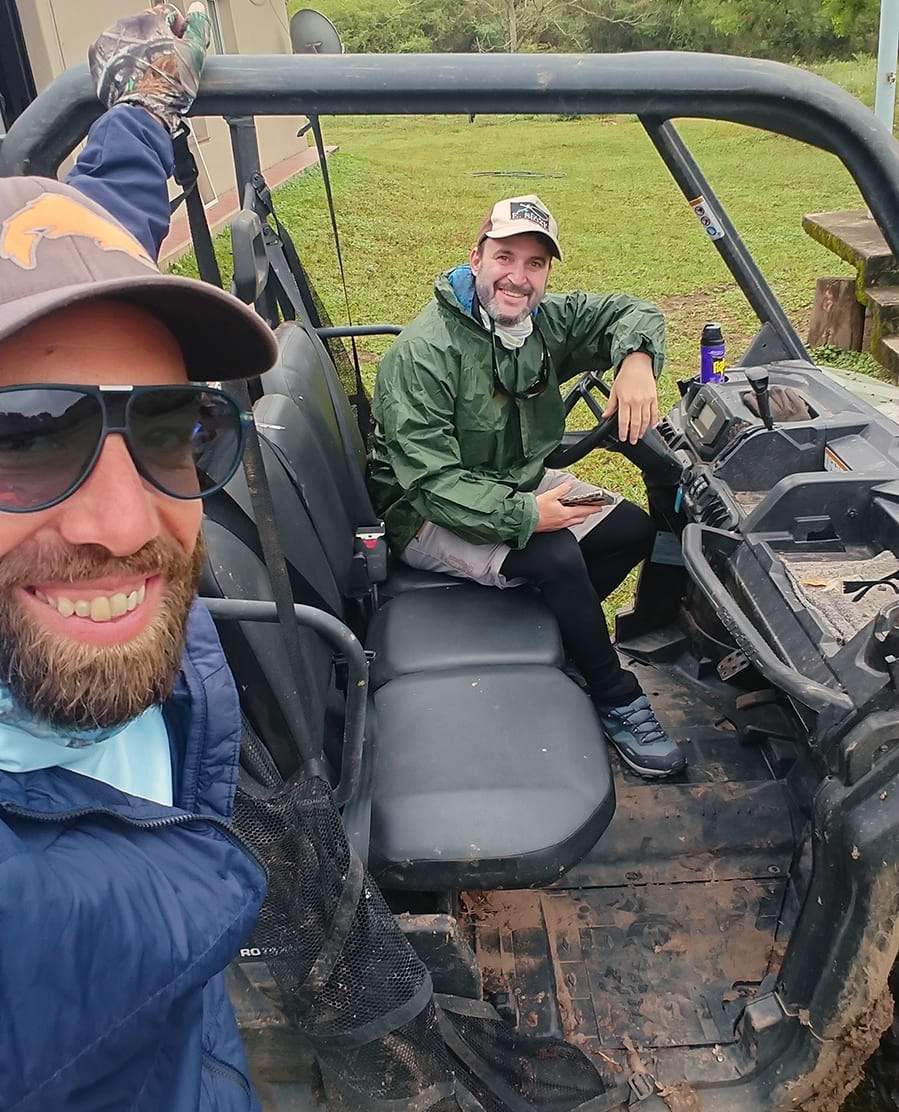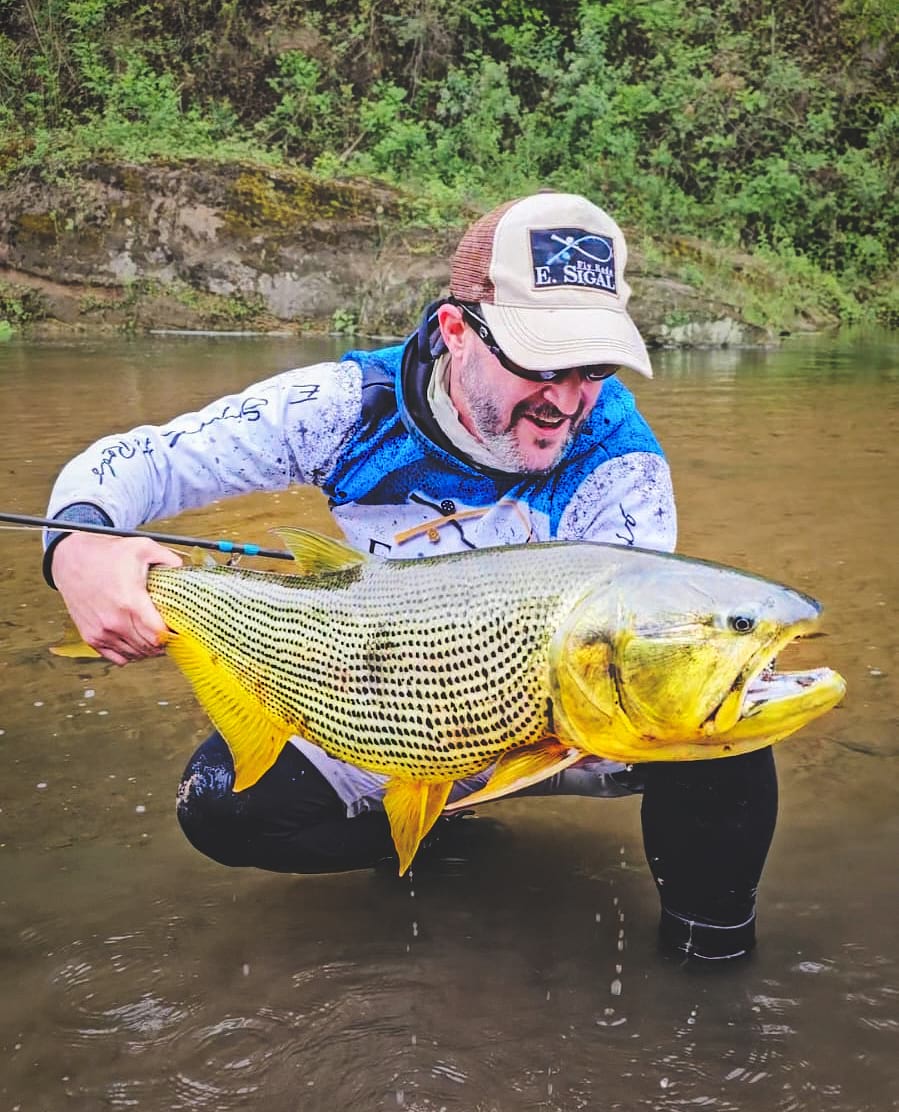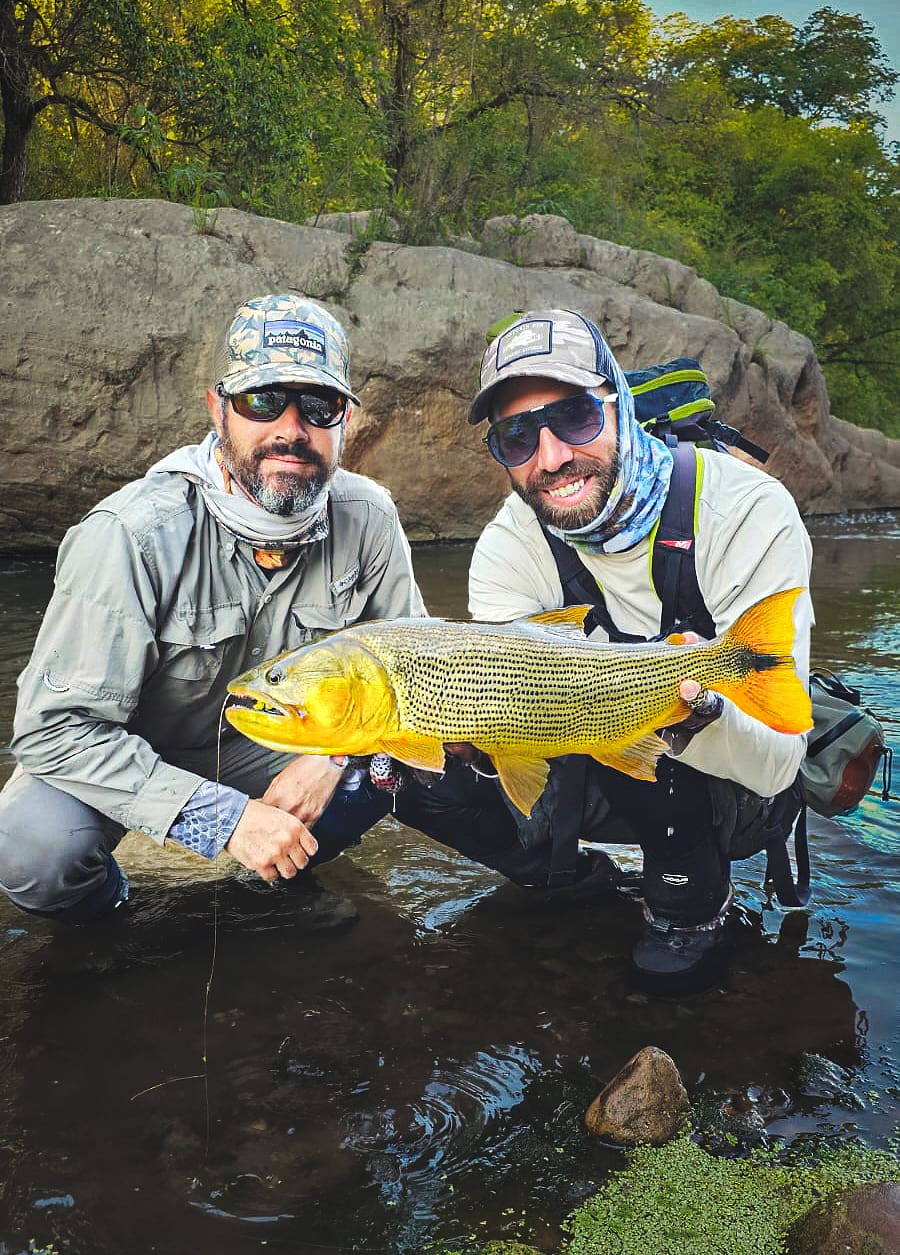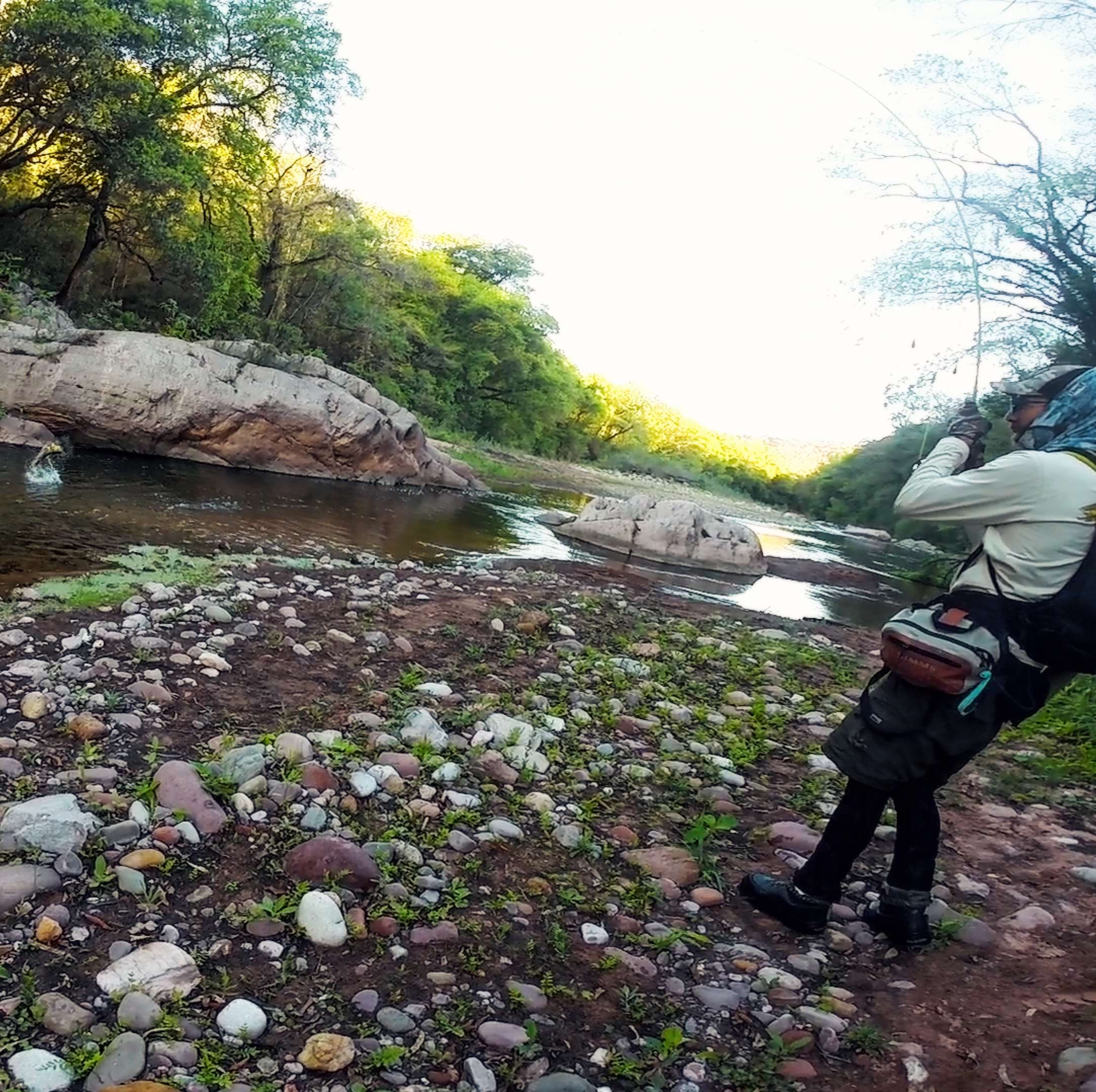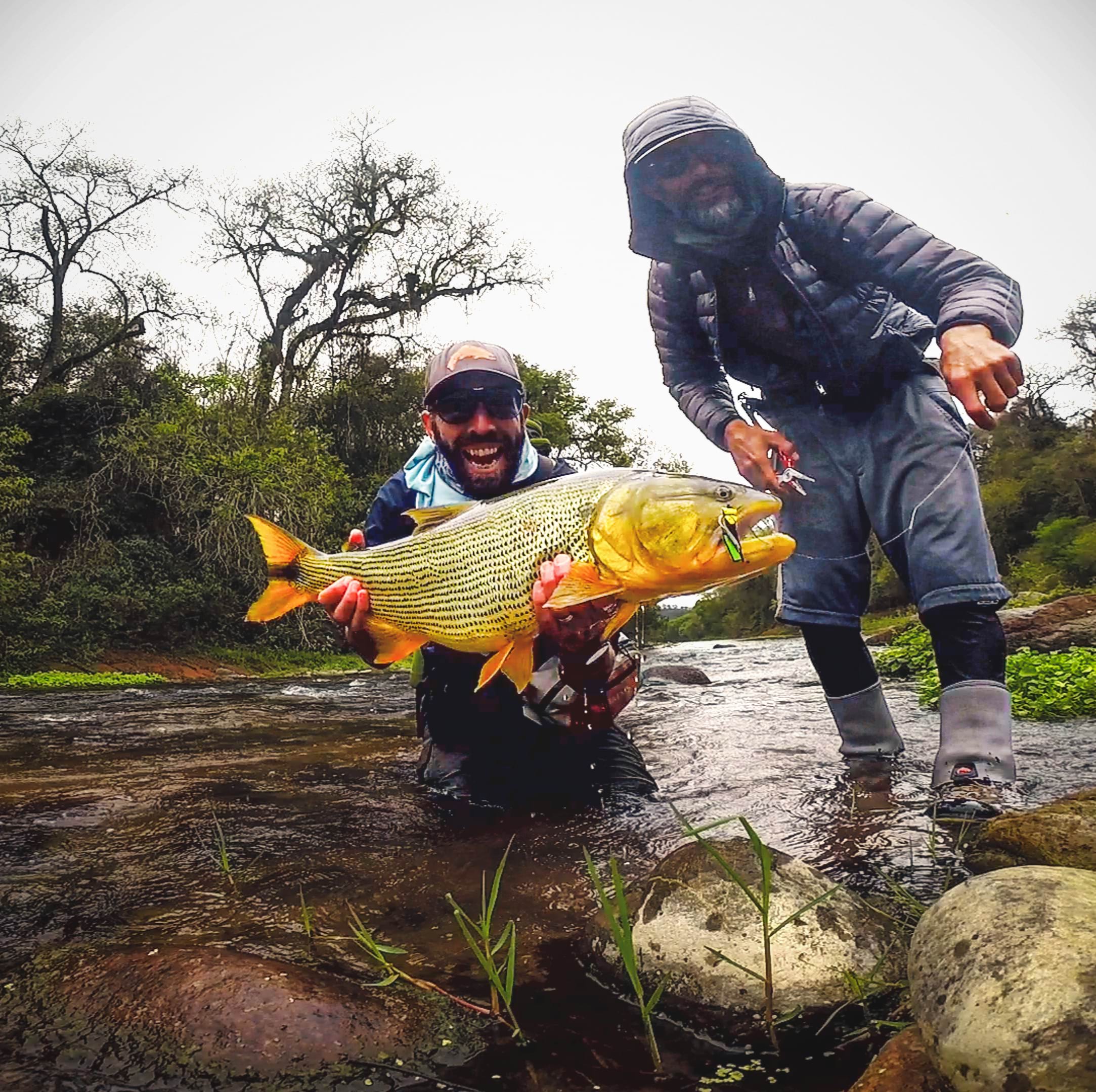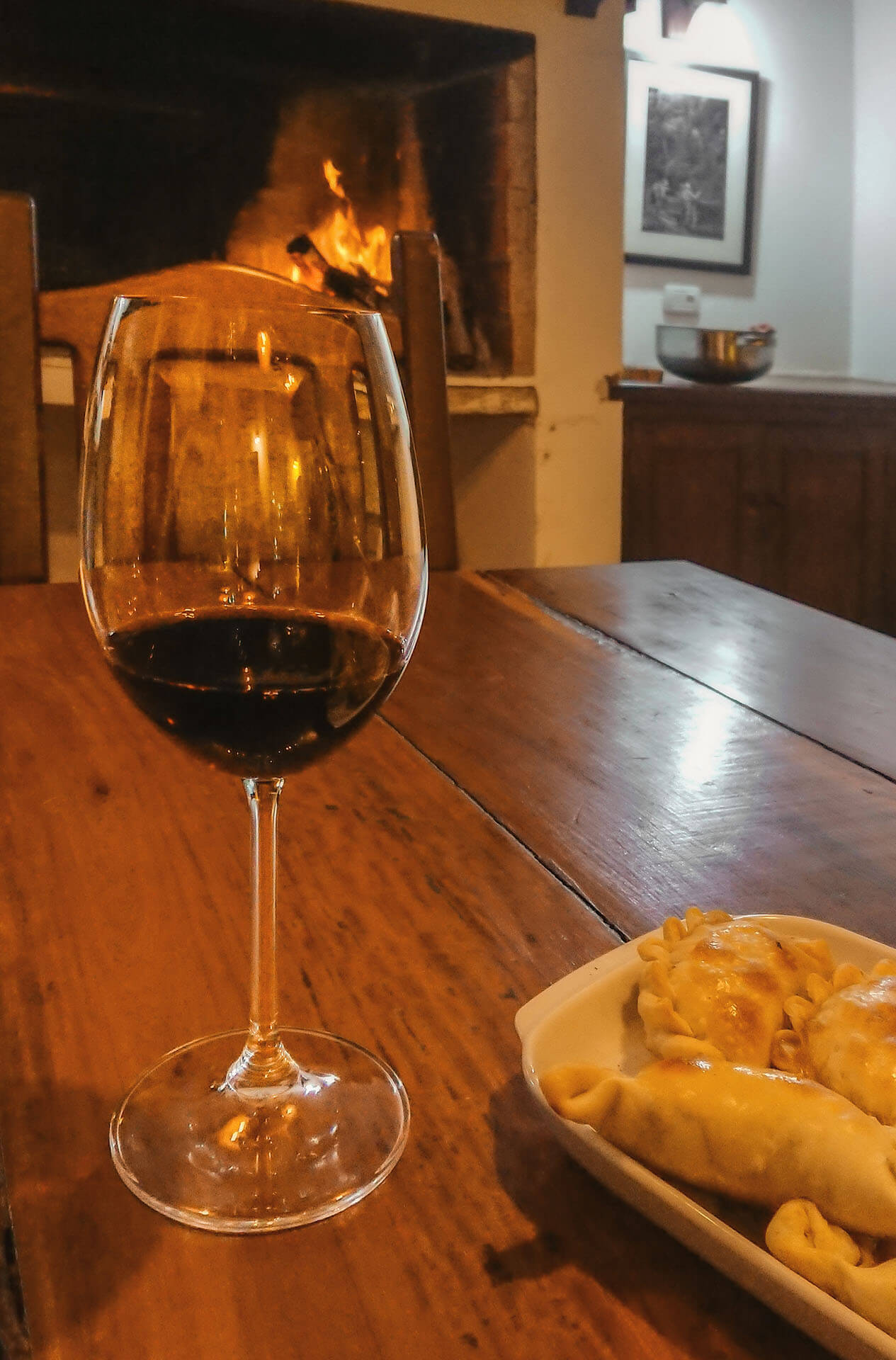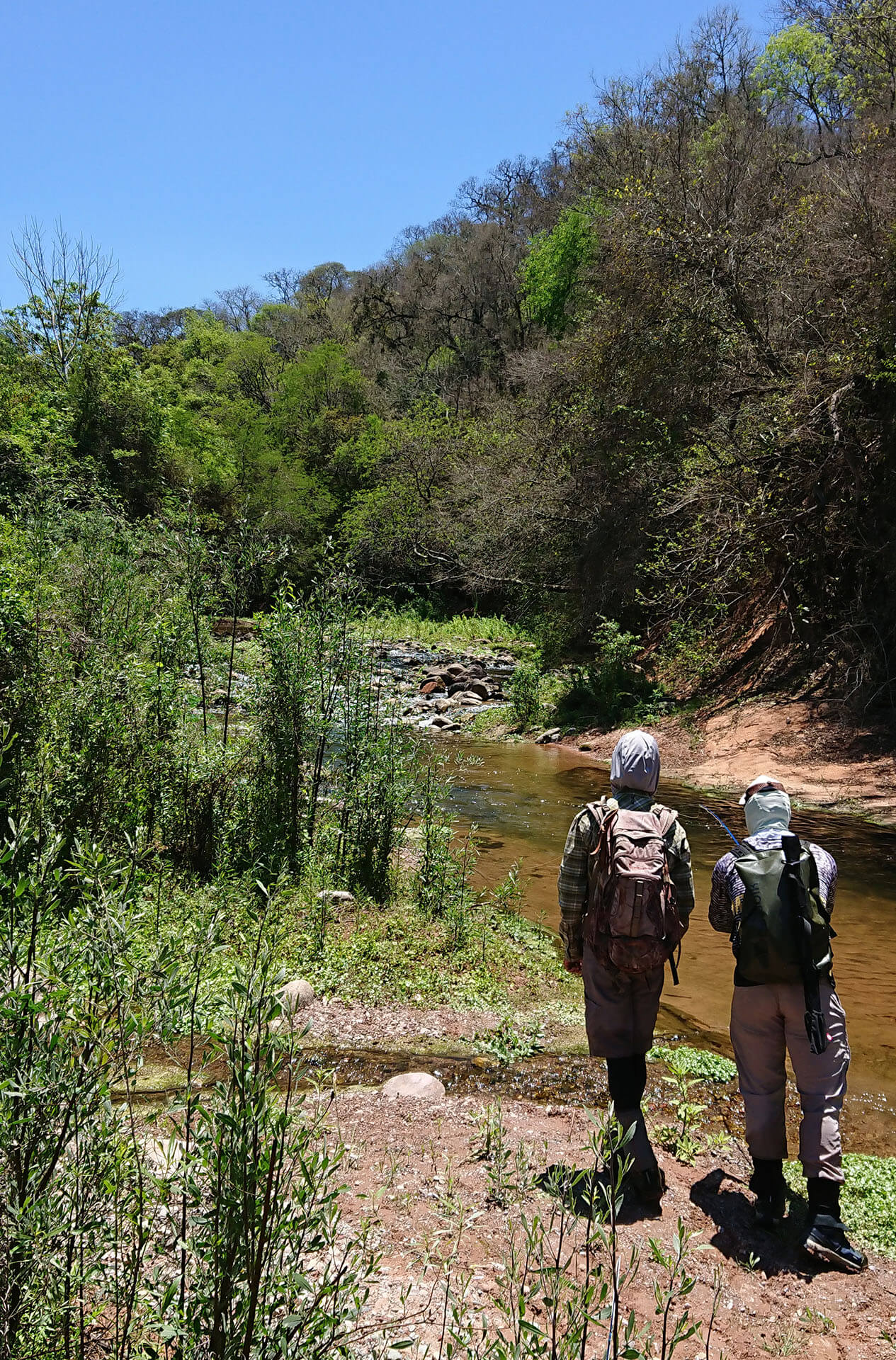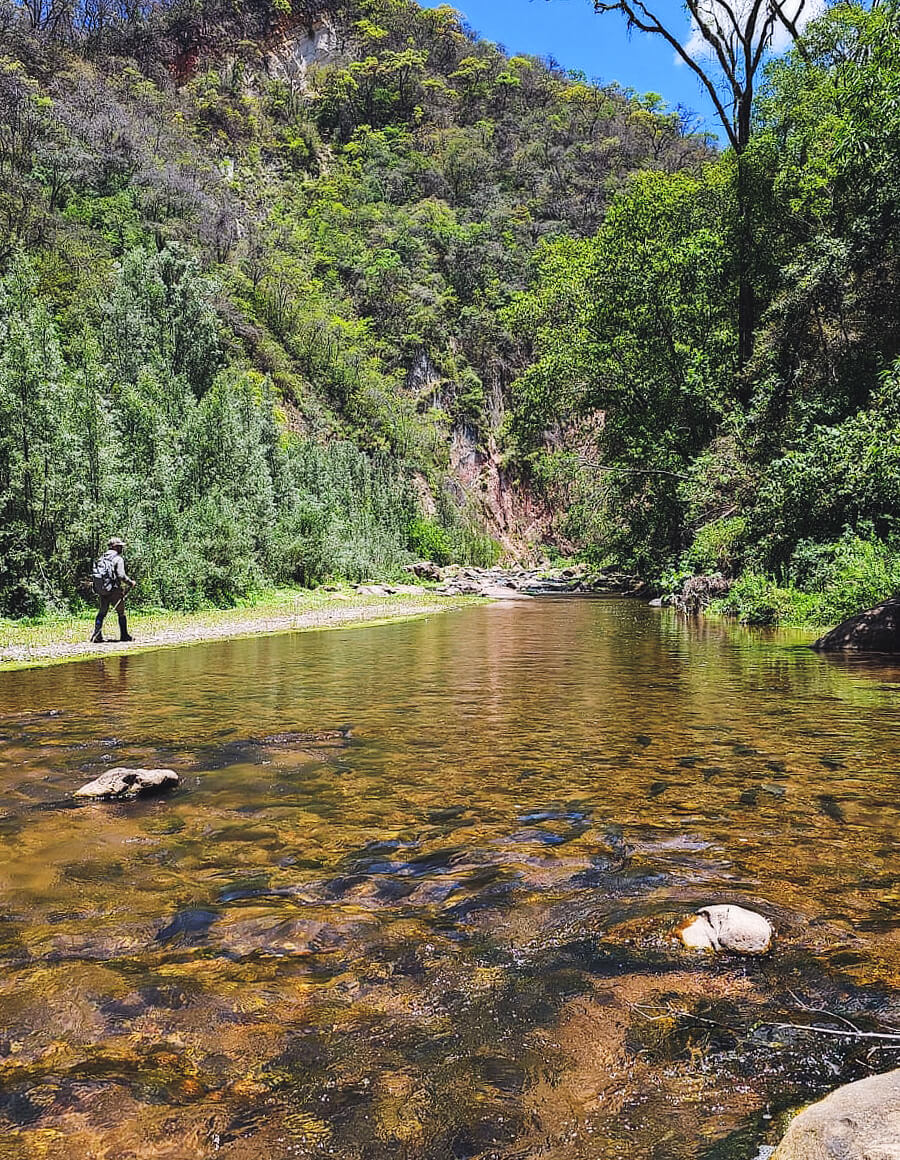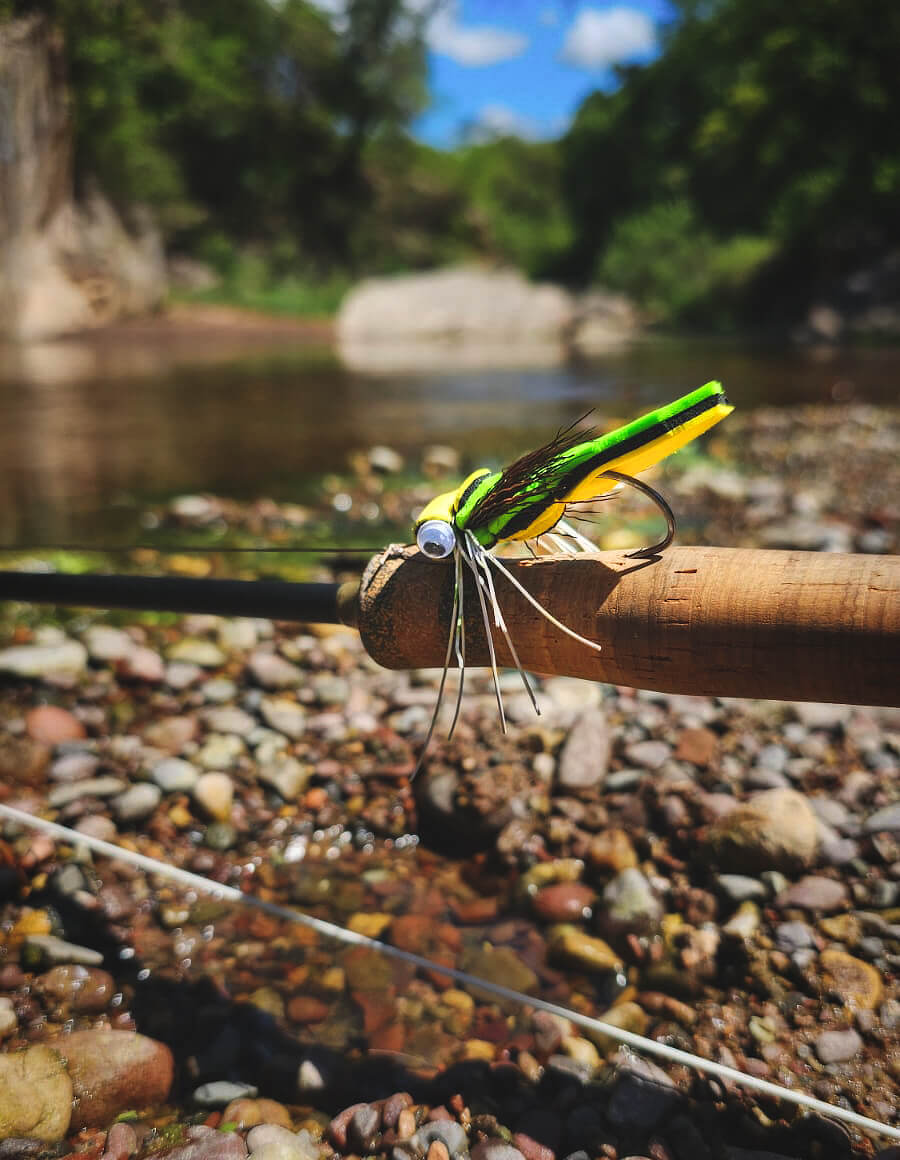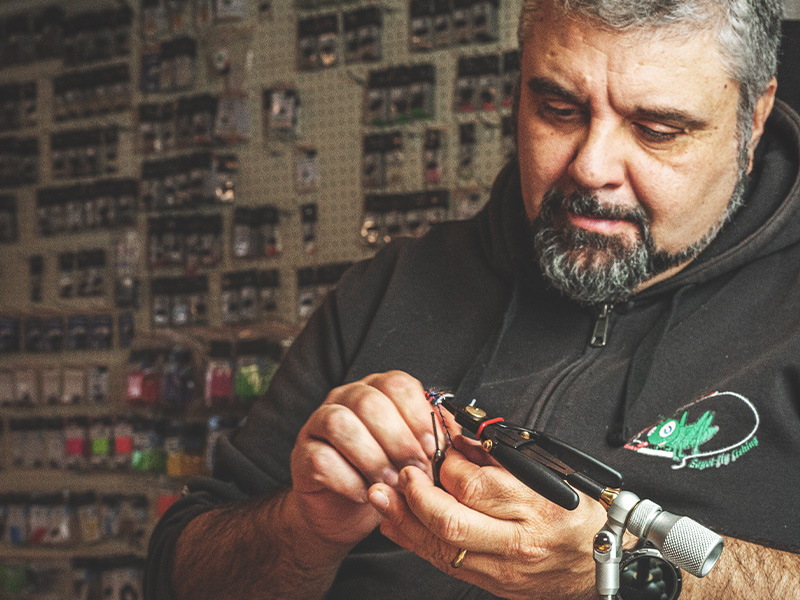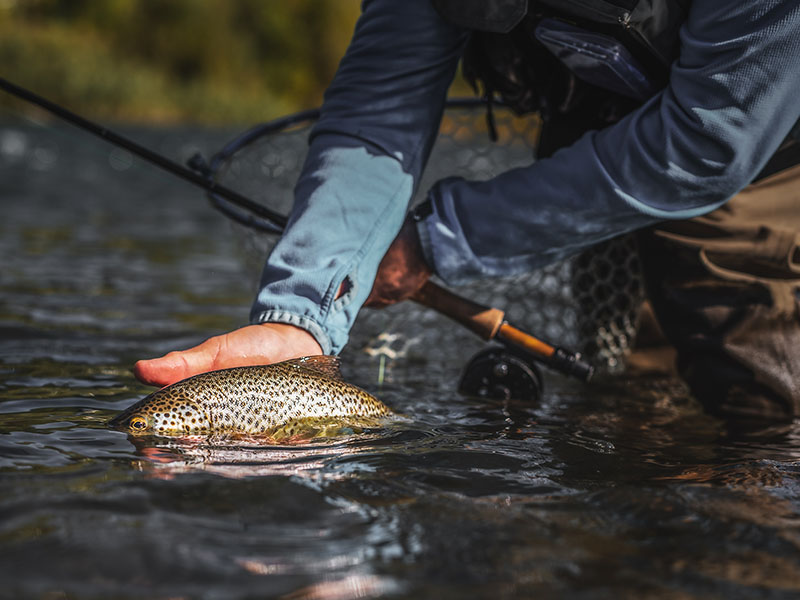INDEX:
- THE PLACE AND THE TRIP
- CLIMATE AND FISHING EQUIPMENT
- THE FISH
- RIVERS AND FISHING
- THE FIRST GOLDEN DORADO OF THE ADVENTURE
- MY FIRST BIG DORADO OF THE RIO DORADO
- SURPRISE AT SUNSET
- RETURN TO THE BASE AND TYPICAL ARGENTINEAN DINNER
- THE DIFFICULT DORADOS OF THE UPPER PART OF THE RIVER
- DORADO CAUGHT ON LAST CAST
- FISHING THE FAMOUS RÍO SECO
- DORADILLOS WITH THE FLY "BICHO"
- RELAX AND END OF THE ADVENTURE
FLY FISHING FOR DORADO IN NORTHERN ARGENTINA
The story I am going to tell you started a few days before my adventure trip, when I needed some materials and equipment that I was missing, and I contacted Markus from the 1000 flies fishing site with whom I have been working for a few years. Once he provided me with what I needed, he wished me luck and asked me to send him some photos of the trip, I agreed and the moment I sent them to him he said wowwww.... why don't you write an article, and we'll publish it on the blog? Actually, I am not a man of many words, more of some videos or photos, but I saw it as an opportunity to give some information to all the fly fishermen interested in the adventure of Dorado fishing, especially with dry flies and in small mountain streams of the country at the end of the world.
So it was, and here we are, I hope to be able to transmit at least a small part of what these experiences and trips to the incredible places of Argentina, my homeland, really are.
1. THE PLACE AND THE TRIP
Approximately 200 km from the city of Salta, Argentina, is the famous and spectacular Río Dorado, a paradise of crystalline waters located in the Yungas of the Salta mountains, where numerous species of fish (Dorados, Bogas, shads, catfish and Mojarras), a great variety of wildlife (tapirs, toucans, pumas and corzuelas) and impressive vegetation and insects of all kinds coexist.
In November 2023, we started our fishing adventure by car, travelling about 1,000 km from the city of Río Cuarto, Cordoba, Argentina, together with my travelling companion and great angler Esteban Sigal (Argentinean manufacturer of bamboo and fibreglass fly fishing rods).
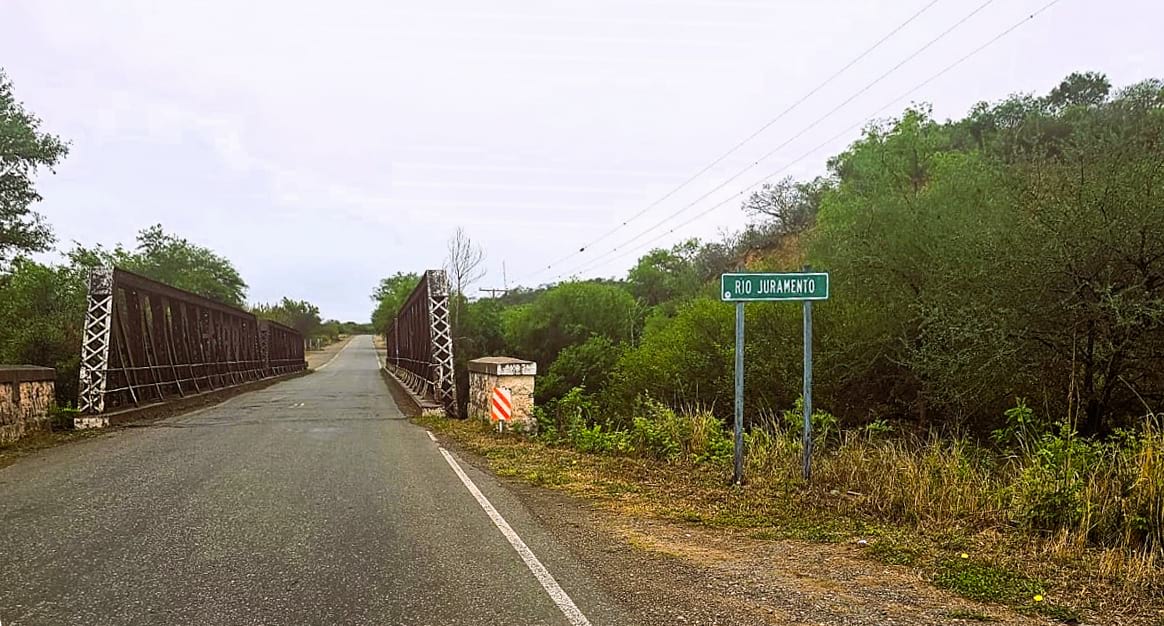
Bridge over the Juramento River, Salta, Argentina
After about 12 hours of travelling between chats, fly tying and some typical meals, we arrived at the town of Las Lajitas, which would be the base and meeting place for the guides of the fishing operation we had chosen to reach the mythical Río Dorado (it is worth mentioning that to reach the middle and upper part of this river it is almost indispensable to enter through private lands without public access to which very few people arrive through this fishing operation and which in turn keep this natural virgin place well-kept and isolated from all human contamination). Once at the site, we changed vehicles as without a 4x4 it would have been impossible to reach the lodge where we would spend the next four days and three nights. After about 40 km or more than an hour of muddy road and rally, we arrived at our destination, where after meeting our guides and a delicious dinner we prepared ourselves psychologically and emotionally to face the first day of fishing in this incredible place that every angler dreams of knowing at some point in his life.
Review:
The lodge is an old rural school used many years ago when in the place there were sawmills that extracted and commercialized the valuable wood of the native trees, today it is in foreign owned lands and local administration prepared to receive with all the comforts to fishermen from all over the world who come to fish and know this virgin paradise of the Argentinean Yungas in Salta.
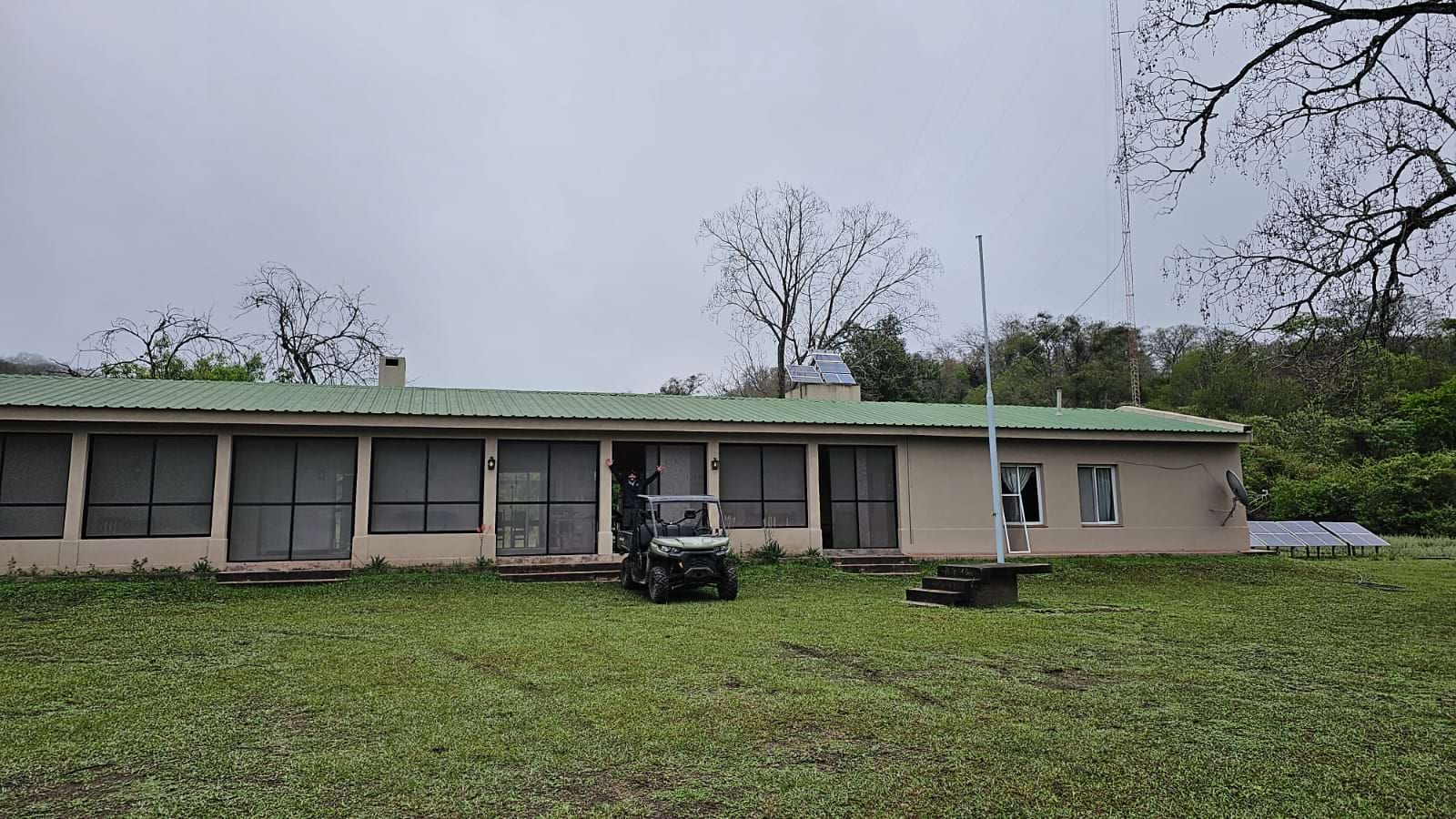
Our Lodge
2. CLIMATE AND FISHING EQUIPMENT
The Yungas of Salta are characterised by a tropical and warm climate in spring (between 15 and 35 degrees Celsius), but as it is the rainy season there are large variations in temperature throughout the day. Our arrival was during a rainy period, so the first day of fishing would have been decidedly cool in the morning and, fortunately, with few insects due to the weather itself (however, you should cover up well because there are always insects such as mosquitoes and ticks ready to bite you).
Fishing clothing for these 100% wade fishing and walking areas should be comfortable and quick drying. Normally fishing backpacks, fishing caps, tubulars for sun and insect protection, polarised glasses, long-sleeved hooded tops or T-shirts with UV protection, long or short quick-drying trousers with tights underneath, neoprene or woollen socks, wading boots or similar, and a waterproof wading jacket is never a bad thing, which in this case came in very handy.
The fly rods we chose were fast action 9- or 10-foot fly rods for tropical or Dorado floating lines from #6 to #8, both for fishing with large dry flies of the attractor type (bugs) or rats and streamers. The reels must be strong, with good reel drags to be able to fight with these imposing beasts, and the leader lines we used were 9 feet long, where the first section was made of 0.60 nylon and the second of 0.50 nylon, topping it all off with a 40-pound steel or titanium tippet with a length of 20 cm to be able to support the teeth that the Dorados have.
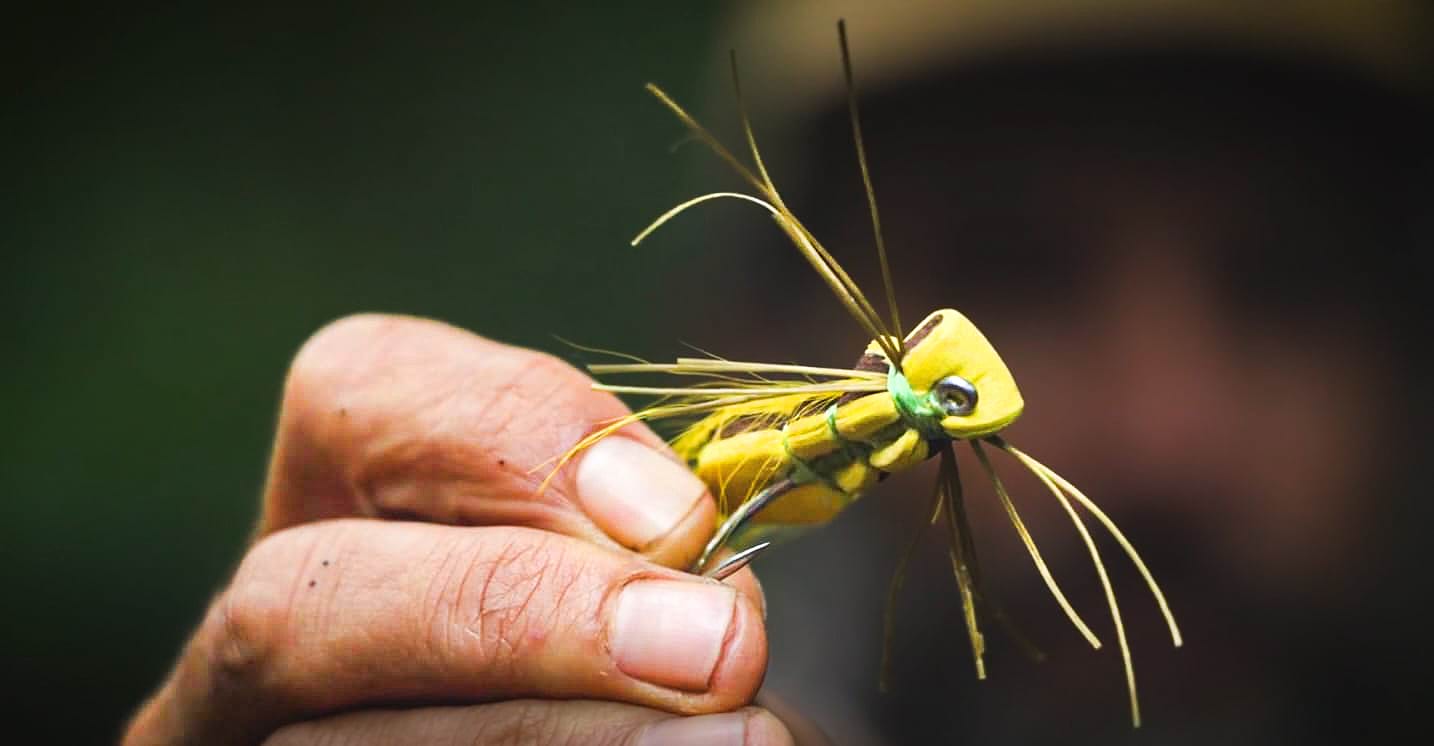
Agustin and the 'bicho' fly
3. THE FISH
The Dorado or Pirayu (Salminus brasiliensis), better known as the "river tiger" for its voracity and strong musculature, is the most popular native freshwater fish among sport fishermen. It is known for its bright golden colour and its ability to leap out of the water when fished in several Argentinean rivers (Río Parana, Río Uruguay, Río Juramento and Río Dulce, among others). This large predator feeds mainly on Mojarras, Sábalos, Bogas and other fish and can reach more than one metre in length and 30 kg in weight, but the most common specimens measure between 30 and 70 cm and weigh up to 15 kg.
The best time to fish for them is spring and summer, but in many rivers, depending on river conditions and closed seasons, they can be caught almost all year round, including winter. In this case it was the month of November 2023, the last part of the Argentinean spring, taking advantage of the fact that it is the last month in which fishing is allowed in the province of Salta, then until March of the following year it is naturally closed due to the rains, and it is the period in which the Dorados can reproduce with tranquillity.
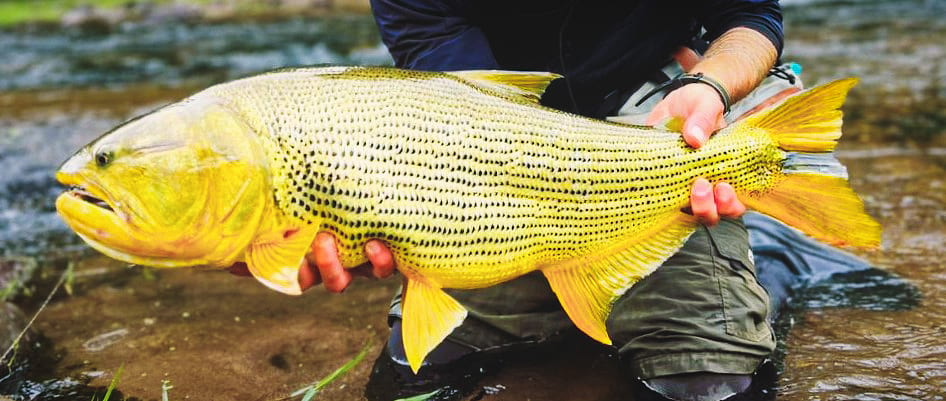
Dorado of the Río Dorado
4. RIVER AND FISHING
After a hearty breakfast and a good rest from the trip, we prepare our fishing gear and head to the river to start our first day of fishing. From the lodge, we drive about 20 kilometres in quads or special 4x4 vehicles, crossing streams, spotting animals and literally crossing the jungle and its muddy roads to reach our destination. One guide for every two anglers, dry fly attractor or bug and the walk begins, listening to the birds singing and the sound of pure nature, going up the river in search of Dorados in this natural fishbowl we have before our eyes.
The fishing in this environment is a hunt for sight fish, that is to say, we walk along the banks of the river very slowly behind the guide without talking loudly or making noise until we spot a Dorado, once we spot the fish (it is not easy to get our eyes used to differentiate Dorado from the other fish found in this river and seeing them will be very difficult at first) we take the line quickly and cast upstream as accurately as possible trying to let the fly drift naturally downstream (there are also situations, especially with small Dorado, where a small movement of the fly makes all the difference). The first cast is crucial for the "surprise" factor; from the second cast onwards, the chances of catching a fish are greatly reduced, as Dorado are immediately alerted to our presence by the line as they fall into the water, kick a stone, or when other fish are startled.
It can be compared to sight fishing for trout in a mountain stream, with the variable and big difference that the feeding behaviour of the Dorado is much more complex and indecipherable. Eighty percent of our normal casts will be totally ignored by the Dorado for one reason or another or they will be alerted immediately and no matter how many casts we make they will not bite or follow the fly, so it becomes a real challenge to try to convince and fool them. If we catch just one nice Dorado (6 or 7 kg) per day per angler it is considered a very good catch in this river, so as we can see fishing here is not easy despite seeing a lot of fish or being very good anglers; the environment, the vegetation and the behaviour of the fish make the fishing really difficult but attractive at the same time.
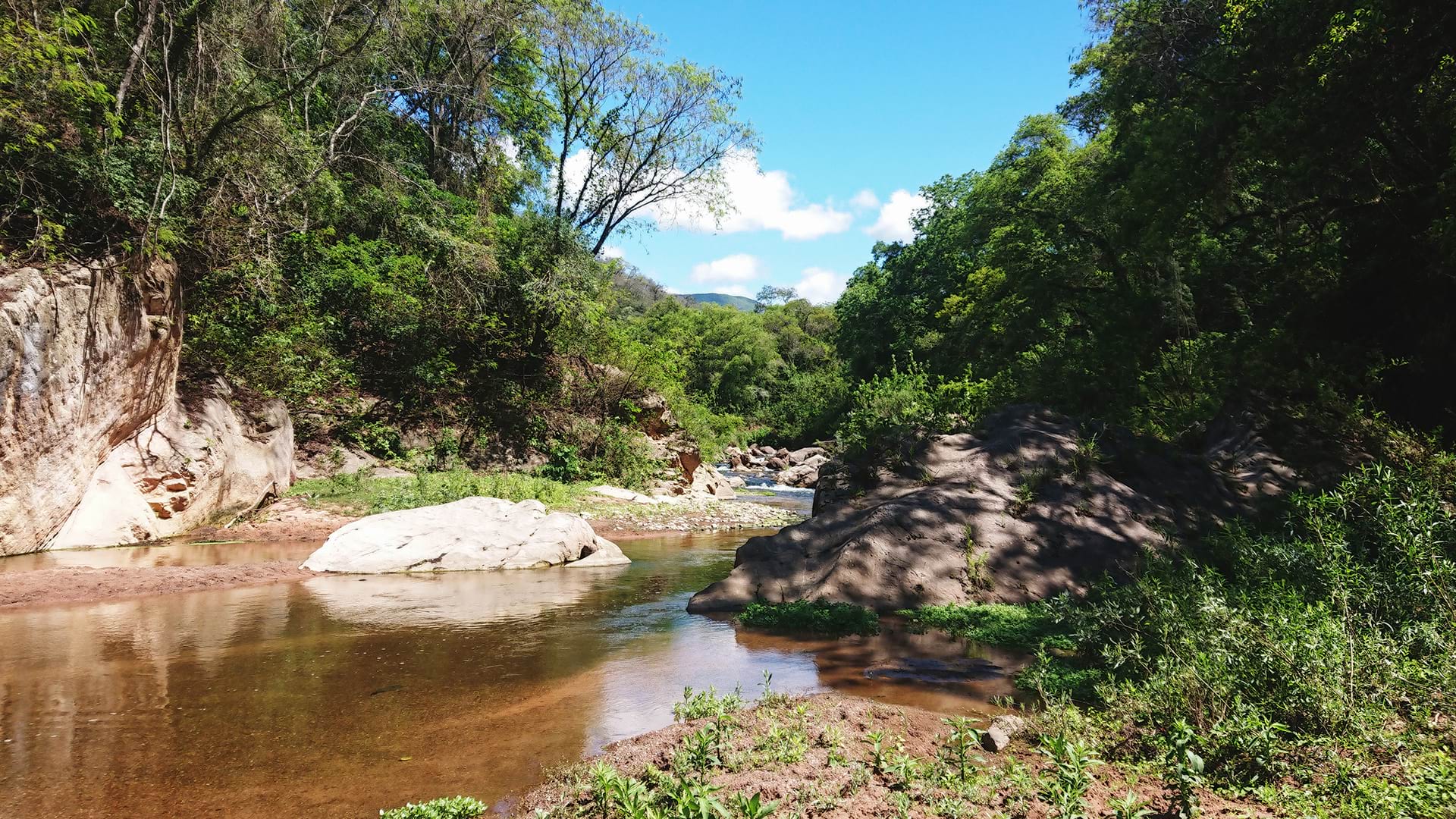
Río Dorado in the middle part
5. THE FIRST GOLDEN DORADO OF THE ADVENTURE
Fishing one spot each with my partner we went up the river between rejections, some fly fishing, but still no concrete bites until our guide Agustin "the larva" (more than 20 years of experience fishing this river since his youth and great connoisseur of the local flora-fauna) in a big pool finds a good Dorado positioned according to him in "active mode", which means that we have many chances of catching it and so it was. Esteban located the fish, quickly took line off the reel and made a cast about 12 to 15 meters upstream near the current, the fly fell into place and a beautiful Dorado of between 5 and 7 kg, spinning subtly, caught it in the best trout mode. After being hooked it made its beautiful leaps, a great fight for a few minutes, after which we took the famous souvenir photo, and the fish came home. .... The first dry fly Dorado caught in a crystal-clear river, very technical and difficult, surrounded by nature of this kind, was a great emotion for my partner and all of us who were there. A good team working together doing everything to achieve one of the dreams that every fly fisherman should fulfil sometime in his life. (It is worth mentioning that there are very few places in the world where we will have the opportunity to do this kind of sight fishing with dry fly for Dorado in small and crystal-clear mountain rivers. In fact, in general, fishing for these fish in Argentina is done in big murky or deep rivers, from a boat or boat and with big streamers of 15 cm or more).
6. MY FIRST BIG DORADO OF THE RIO DORADO
After a good lunch on the river, some chatting and a good rest on the rocks on the bank, we continued our hunt upstream, taking turns to fish the various spots the area had to offer, until the guide pointed out some active Dorado in a rocky stream in a biting position. At the same time, much closer to me and away from the ones the guide was watching, I see a big Dorado behind a rock which from my trout fishing point of view was nymphing, although this is very unlikely. I make a short cast of 5 or 6m, the dry fly "bicho" falls a little behind the fish that curiously approaches to observe it, as a delicate trout rises to eat this big insect that falls into the water and boom ... . The Dorado began to fight against the current with an incredible force and speed until it took most of my backing (my reel was not braking very well). Between the shouts of the guide giving me advice not to lose the fish and my fishing partner filming me after a few jumps, the Dorado got tired and I was able to bring it closer to the shore and, after a spectacular memorable photo, I released it and returned it to its habitat. My first Dorado of this trip caught and seen by me had double the value, even more so for a 6-8 kg fish in a context like this! A beautiful story that will remain forever engraved in my memory!
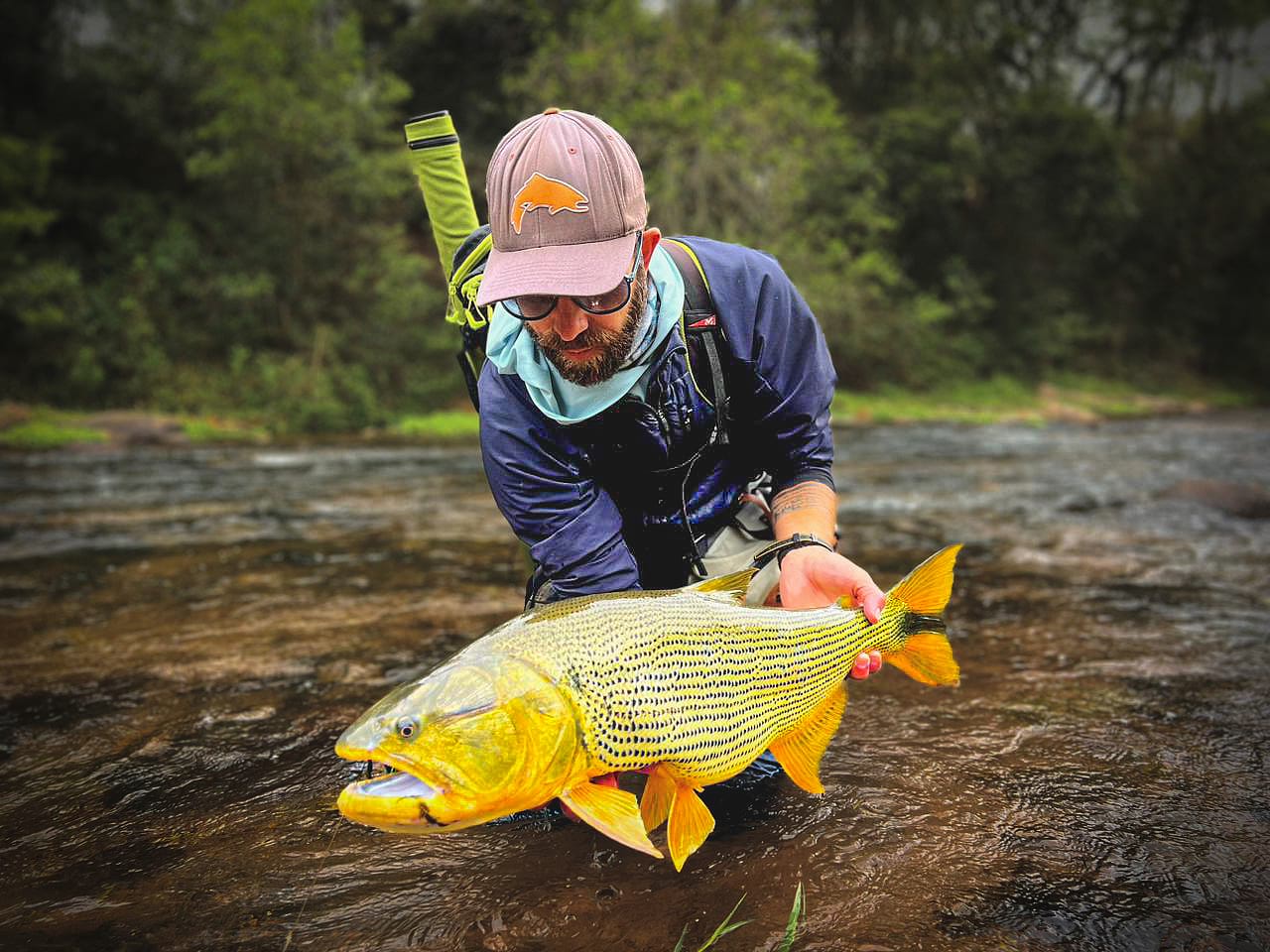
My first Dorado on this trip
7. SURPRISE AT SUNSET
The afternoon went by with the weather still cloudy and cool as in the morning, with some shy bites that we couldn't manage, many rejections and scaring away the sensitive fish that inhabit this river with some wrong casts. We arrived at one of the last fishing spots before starting the walk back to the vehicles, the guide told us to make our last casts in this place or well that they know and to which they have already given a name. In this case the area was called Puerta del Potrero and was the point where the middle and upper reaches of the Río Dorado split.
Upstream, as always, Esteban, at the request of our guide, cast into the white foam, which is always found on the downstream side of the river, and as soon as the fly broke the foam and touched the water, a voracious Dorado of about 3 kg came out from below and violently took the dry fly. ... from that moment on, it was all jumps, a fight and a photo to remember! This time it wasn't a sight fish, but the surprise factor and the violence with which this Dorado attacked the fly also charged us with adrenaline and gave us unforgettable moments!
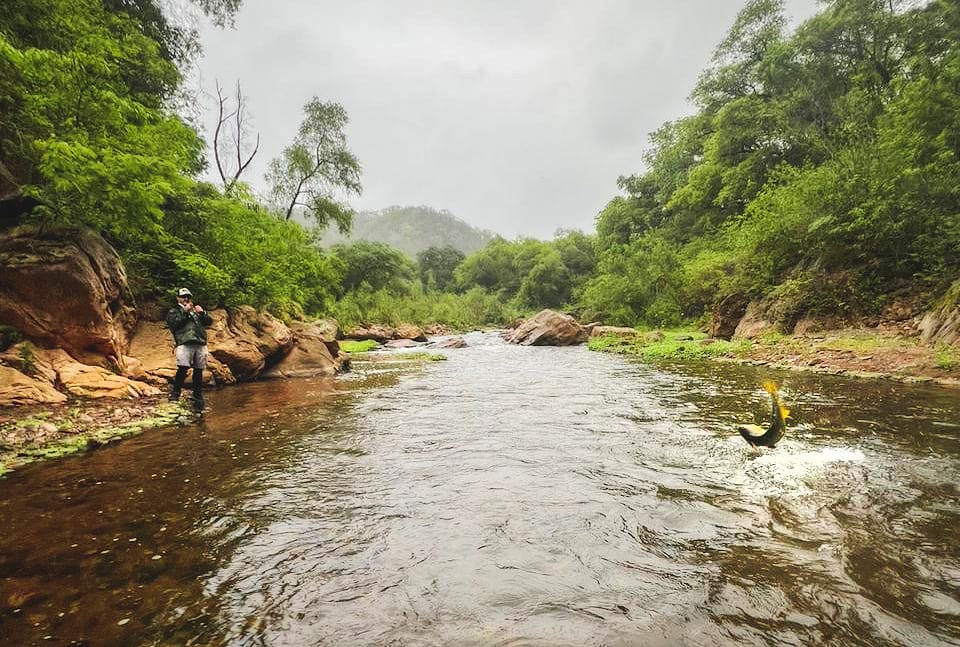
Esteban fighting a Dorado
8. RETURN TO THE BASE AND TYPICAL ARGENTINEAN DINNER
Returning along the paths that shorten the way back, created by the guides themselves in the forest in the middle of the native and rustic vegetation, to be able to reach the vehicles faster when it is about to get dark, the first day of fishing in this earthly paradise came to an end for us.
We dismantled the rods, got into the vehicles and headed back to the lodge, where a delicious post-fishing snack awaited us, our classic fried meat empanadas. There we met two other fishermen, who had just arrived and were able to fish for half a day in the afternoon in a stream closer to the lodge, the Río Seco, which hides some very good fish, but had not shown them any of its golden treasures that afternoon.
Between good grilled meat, good company and good red wine from the north of Argentina, the second night in the mountains of Salta was coming to an end, between anecdotes and chats about the first day of fishing and imagining what would happen the following day, when we would go to see the upper stretch of the Dorado river, very famous for the big and difficult Dorados that populate its waters.
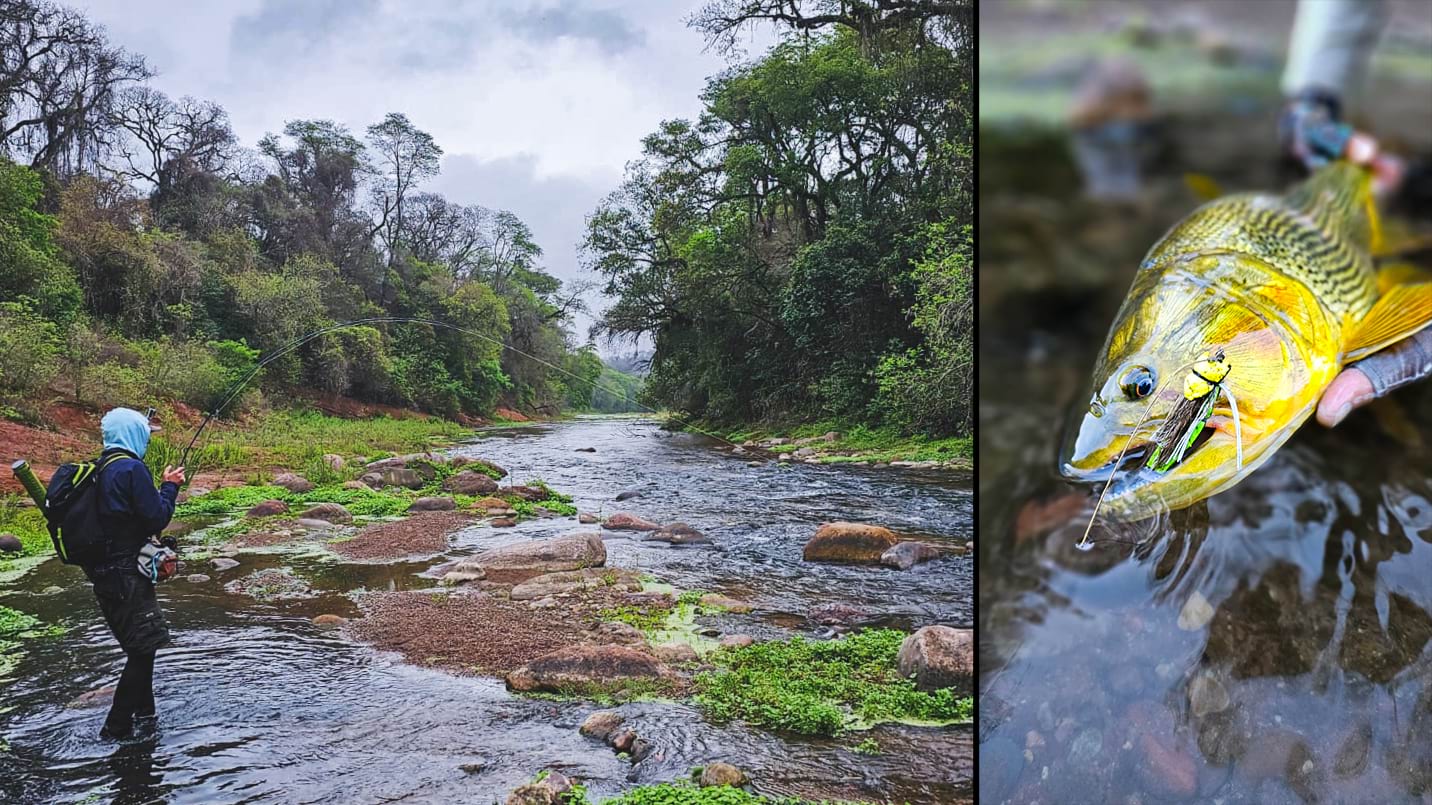
Left: Playing a Dorado - Right: Doradillo and the winning fly
9. THE DIFFICULT DORADOS OF THE UPPER PART OF THE RIVER
The second day started with croissants and coffee with milk at 7 am. A cool but sunny morning awaited us; after chatting and trying out some equipment with the other anglers and guides, we loaded our backpacks with our respective equipment to set off on a beautiful walk along the upper stretch of the Dorado River, this time accompanied by our guide Fernando. After the second rally through the jungle and its trails, this time with the ATV we arrived at the midpoint of the river and from there we walked about 6 or 7 km upstream with our equipment still unarmed along the trails of the forest, observing the great flora, and tasting some of its fruits, in this case the lemons of the forest.
Once we reached the end of the middle part of the river, we set up our gear and started fishing upstream in the upper part of the Río Dorado. This area where the river gets a bit smaller is inhabited by incredibly big Dorado and a natural landscape rarely seen before. We managed to spot many fish, unfortunately very difficult to catch. We arrived at midday with only two fly chases, but no concrete strikes.
After lunch and a good hour's rest on the river, we continued fishing upstream with rats and big dry flies (bugs), but with no results despite seeing them in front of our eyes. Although we had done things right, not making noise and being careful to try to fool them, it seemed impossible that day, they were not very active and did not want to attack our flies. After many unsuccessful attempts we reached the last fishing spot where we had no luck. On the way back to the vehicles, still with the equipment mounted and without giving up, we tried a few casts downstream (this river can be very frustrating and mentally exhausting for any angler, no matter how experienced, the important thing is to always keep focused on what can happen and never give up).
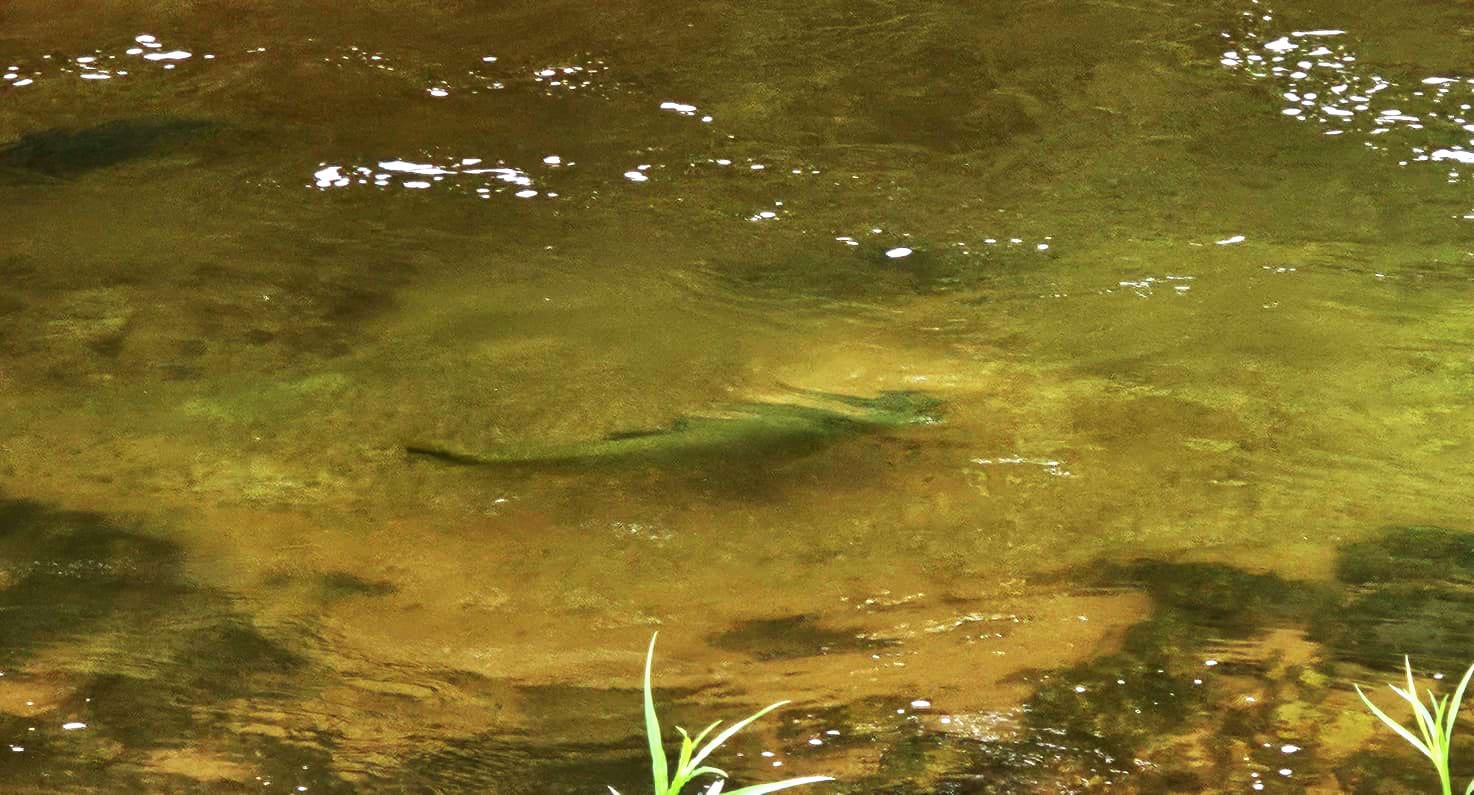
Dorado in focus underwater
10. DORADO CAUGHT ON LAST CAST
My average on the Río Dorado was at least "a fish a day", I had never left the river without catching and photographing one of its treasures, and this day would be no exception. Arriving at the last point before starting to dismantle the equipment, my partner and the guide tried again in a place where the Dorados had timidly followed the fly without getting a bite. I moved forward a couple of metres and made a few casts in a spot that looked good to me; after the fly crossed the current skating tensely on the water, I saw how a beautiful Dorado of about 3 kg came out furiously and attacked my fly; after a few jumps to escape downstream and a great fight he let himself be photographed with us, crowning our day at the last minute. Once again, the river did not let me go without enjoying one of its treasures on one of the days when it was really difficult to think that I could fool them. In the end it happened, and so we were able to start our way back, walking along the paths of the Salta mountains full of the satisfaction that that last incredible fish gave us.
We returned to the lodge where the classic post fishing snack awaited us, and commenting on the hard day's fishing we had on the upper part, the other two anglers fishing downstream had a very productive day for them with a total of 4 medium Dorado and lots of streamer activity fishing upstream!
Between stories and a delicious dinner we started to organize what would be the last day of fishing this time in another river, still unknown to me, which is only 15 minute walk from the lodge, the famous Río Seco, another pearl of the Salta mountain with crystal clear waters, smaller than the Río Dorado, but with more voracious juveniles, which makes that sometimes, when the fishing gets tough with the big ones, we enjoy fishing with dry flies for smaller Dorados with the always latent possibility of a surprise or two.
11. FISHING THE FAMOUS RÍO SECO
After a well-deserved rest, we started the third and last day of fishing in the Yunga with a delicious breakfast, after which we prepared our equipment and set off on the trail that would take us to the river. Last excursion under the sun of that beautiful morning listening to the song of the toucans in the middle of the virgin forest, we arrived at the fishing area, with our rods ready, we started our last hunt for the "river tiger" in a river that we fell in love with, even smaller and more transparent where we would have to fish very carefully due to the great sensitivity of the Dorados that inhabit it.
This time we were two anglers and two fishing guides. Fernando (one of the guides) was in his first season of learning from the other guide (Agustín), a native of the region who has been fly fishing in these rivers for more than 20 years, before fishing operations existed, and who through trial and error has learned and continues to learn the behaviour and way of fishing the difficult Dorados that inhabit these waters.
12. DORADILLOS WITH THE FLY "BICHO"
We get to a very good area and it's my turn to cast, my guide shows me a couple of juvenile Dorados with a good predisposition to take the fly (if the Dorado is still upstream in the middle of the water we have a good chance that if we make a good first cast it will take the fly, if it is swimming downstream or upstream or is very slow at the bottom of the river it is more difficult for it to take the fly).
Quickly I remove the line from the reel and between the branches of the bank I try to make the best possible first cast which is fundamental, the fly falls in the indicated zone and almost before touching the water a beautiful Doradillo takes voraciously my dry fly automatically lifting the rod, I nail him and make him fight. After a few moments and only in the middle of the morning I already had in my hands the first Dorado of my last day, which after some souvenir photos we returned with the due care and as fast as possible to its natural habitat (it is necessary to point out that when fighting with a small Doradillo it is important to reduce to the maximum the time of fight since the big ones can take advantage of these circumstances and end up eating it during the fight! A madness that I have experienced on several occasions).
In the meantime, my fishing partner had also had a chance, but this time the Dorado won the short fight. In two hours, we had already had more activity than in the whole of the previous day. Fishing is like that; you never know what might happen.
The morning continued to be productive (we saw lots of Dorado following the Sábalos and Bogas that are their prey. These rivers are so full of life that when we are there, we are surprised by the number of fish that inhabit them. We would say that we are kicking fish when we cross the river, but not all of them are Dorados, I calculate an average of 1 Dorado for every 30 Sábalos, so imagine the amount of food that these beasts have) with more bites and other opportunities that we missed we arrived to a very good spot where my partner managed to catch his first Dorado of the dry river around midday.
13. RELAX AND END OF THE ADVENTURE
With a fish each and a souvenir photo we returned to the lodge with the 4x4 that was waiting for us upriver for lunch and a well-deserved "siesta"; taking advantage of the proximity of the river, we would return a couple of hours later for our last afternoon of fishing.
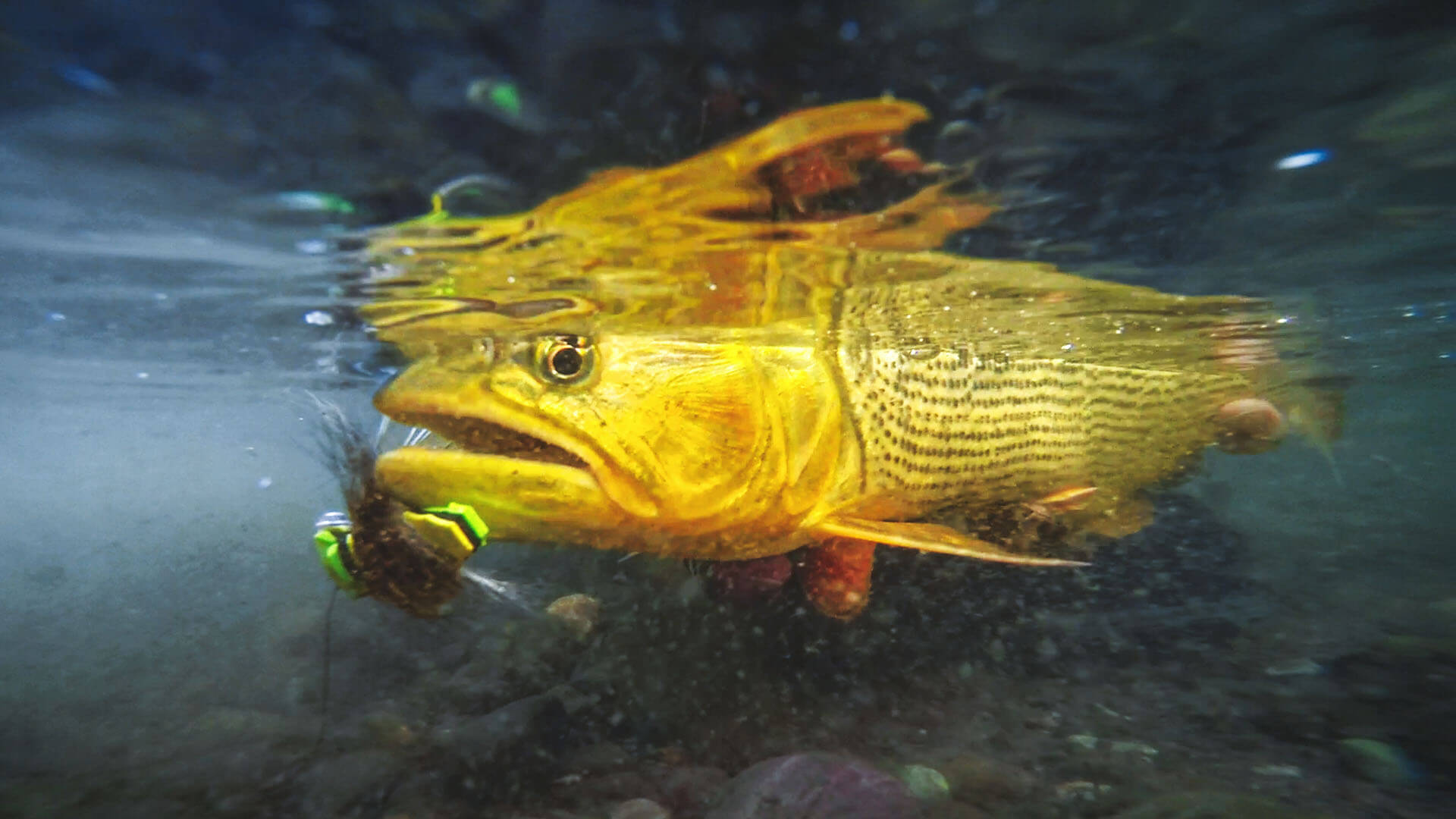
Underwater and on the fly
Back on the river we enjoyed the little time we had left in that magical place, having a cool drink and smoking a good cigar, the afternoon passed between chats, anecdotes of the trip and experiences. Still fishing (the Dorados won that afternoon, very skilful) surrounded by incredible flora and fauna, the sunset awaited us with the pleasant surprise of crossing the river with the famous Tapir, one of the emblematic animals of this place.
Back at the lodge, enjoying a good fernet cola in the last asado of the Yunga salteña, with the good people we met and who treated us wonderfully and thanking life for having given us the opportunity, we said goodbye to this beautiful place of which we take many memories, with the desire to return someday to meet face to face with its terrible Dorados, there in the middle of the virgin nature of the mountains of Salta, in the north of my beloved Argentina.


